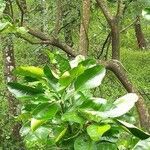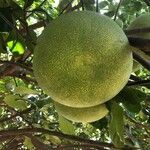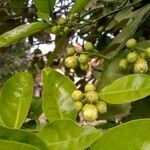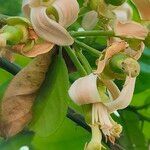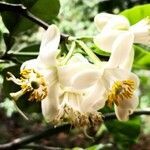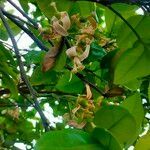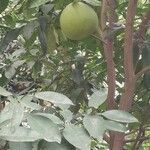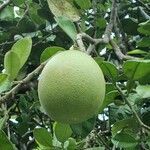Bushy tree to c. 10 m high, usually spinescent; spines strong, to 5 cm long; branchlets angled, finely pubescent. Leaves: petiole 1.5–4 cm long with broad wings, c. 1 cm or more wide; lamina elliptic or ovate, c. 5–12+ cm long, to c. 2–8+ cm wide, coriaceous, discolorous, entire or shallowly crenate, midrib pubescent below. Flowers usually in 5–10-flowered racemes, occasionally solitary, fragrant; rachis 2–6 cm long, pubescent; pedicels 10–30 mm long, pubescent. Calyx campanulate, 5–10 mm long, usually shallowly 4-lobed, shortly pubescent. Petals usually 4 (sometimes 5), 17–25 mm long, white. Stamens with filaments 11–15 mm long; anthers linear, 2–3 mm long. Style 8–12 mm long. Fruit globose to broadly obovoid, (7–) 12–21+ cm diam., yellowish green; skin/peel pithy, 1.5–2 cm thick, adhering; pulp white, pale yellow or pink, sweet or slightly bitter. Seeds wrinkled.
A spreading, spiny tree. It grows up to 15 m high. It is dome shaped. The leaves are very large. They are glossy and oval and downy underneath. The leaf stalks have broad wings. Young shoots and stems have fine hairs on them. Flowers are large (2 cm) and creamy white. The flowers are produced in bunches from woody shoots. The flowers have a sweet scent. The fruit are oval or pear shaped. The fruit is very large (20 cm) with a thick skin. The skin is dotted with oil glands. The fruit are green but become yellow when ripe. They contain 11-14 segments. The flesh can be pale yellow or pink. Each segment of the fruit is covered by a strong membrane. Some kinds have many seeds, while others are almost seedless. There are several named cultivated varieties.
A hybrid between pummelo and mandarin. It grows 5-6 m high but can be 12 m high. The young stems have short supple thorns. The leaves are larger than orange and smaller than pummelo. They are 7-15 cm long and oval but not pointed. The fruit are between a pummelo and an orange in size. They are round and can be 10-15 cm wide. They are smooth and pale yellow.
